Mars: A Century of Exploration
A Crewed Mission to Mars
The logistics of a crewed mission to Mars are complex to say the least.
Not only must the engineering problems be addressed, but the philosophical
issues pertaining to our interference with the natural evolution of another
planet must also be resolved (especially if extant Martian life is
discovered).
There are three categories of risk environments in such a mission:
- Active Space Environment. This includes the phases
of launch, orbital maneuvers, and atmospheric entry (all of which occur
either at Mars or the Earth). The only fatal accidents in both the U.S.
and Russian manned spacecraft have occured in launch or landing. This is
the highest risk phase of the mission.
- In-Space Environment. This segment of the mission is
composed of the time spent by the crew in transit between Earth and Mars.
The expected hazards are exposure to radiation and zero gravity. This is
an "intermediate risk" phase of the mission.
- Planetary Surface Environment. This is the lowest
risk segment of the mission. The astronauts will be under the influence of
a gravitational field that is 1/3 that of the Earth's and will have some
protection from the radiation hazards of space in the form of the Martian
atmosphere and the presence of the planet itself.
With these risks considered, it would be best to minimize transit time and
maximize surface operation. A description of one option is given below
(although the dates given are very tentative!).
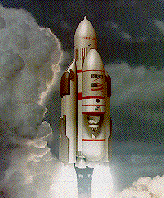 Approximately every 26 months, Mars and Earth are at their closest
together. During 4 of these "launch windows," several launches will be
performed - some sending supplies and some sending astronauts - to Mars.
Approximately every 26 months, Mars and Earth are at their closest
together. During 4 of these "launch windows," several launches will be
performed - some sending supplies and some sending astronauts - to Mars.
Conventional chemical rockets will be used to launch Mars-bound spacecraft
into low Earth orbit (LEO). A liquid hydrogen nuclear thermal rocket (NTR)
will be used to transfer the vehicles from LEO to Mars. The NTRs use about
1/2 as much fuel as conventional chemical rockets. The technology for the
NTR was developed to near-flight status in the 1960's.
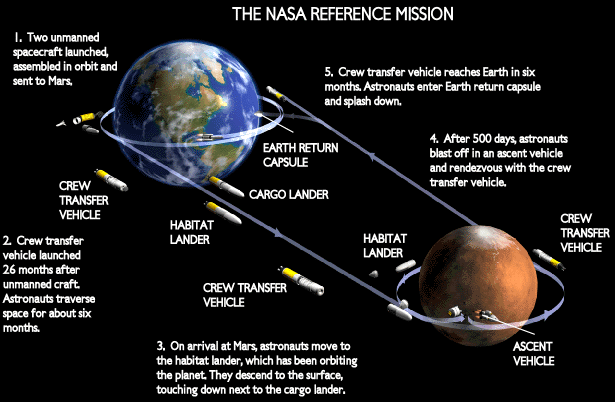 In September 2007, 3 launches will be performed. The
first will send a fully fueled Earth return vehicle (ERV) into Martian
orbit. The ERV will return the crew to Earth and splash down like the old
manned missions from the 1960's. The second launch will send to the
surface of Mars an unfueled
Mars ascent vehicle (MAV), a liquid oxygen/methane propellant production
module, a 160 kW nuclear power module, a supply of liquid hydrogen, a
utility truck and a pressurized rover. The third launch will send to the
surface of Mars a surface laboratory, a second 160 kW nuclear power module,
a utility truck, tools, and spare parts. The surface laboratory will
contain the food supplies for the crew.
In September 2007, 3 launches will be performed. The
first will send a fully fueled Earth return vehicle (ERV) into Martian
orbit. The ERV will return the crew to Earth and splash down like the old
manned missions from the 1960's. The second launch will send to the
surface of Mars an unfueled
Mars ascent vehicle (MAV), a liquid oxygen/methane propellant production
module, a 160 kW nuclear power module, a supply of liquid hydrogen, a
utility truck and a pressurized rover. The third launch will send to the
surface of Mars a surface laboratory, a second 160 kW nuclear power module,
a utility truck, tools, and spare parts. The surface laboratory will
contain the food supplies for the crew.
In October 2009, there will be 3 launches. The first
will send a second fully fueled ERV to Martian orbit (there will be a good
deal of redundance in the systems, of course). The second launch will send
a second unfueled MAV, spare parts and such to the Martian surface. The
third launch will be the first crewed vehicle to Mars!
The travel time to Mars will be about 180 days. The crew will be at Mars
for 500--600 days. The first crew will likely consist of 6 or 7 individuals
with a diversity of expertise (engineering, medicine, geology, social
science).
In December 2011 and March 2014, there
will be 3 launches similar to the situation in 2009. This will mean
12 launches from Earth, 3 of them crewed, and a mission lasting
a total of 9 years.
 Once at Mars, an aerocapture manuever will be used by both arriving cargo
and crew modules to enter Mars orbit. This saves both spacecraft mass and
fuel. The descending modules
Once at Mars, an aerocapture manuever will be used by both arriving cargo
and crew modules to enter Mars orbit. This saves both spacecraft mass and
fuel. The descending modules
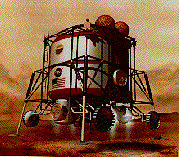 will then use their aeroshells to enter the
Martian atmosphere and will slow for landing using either parachutes or
rockets.
will then use their aeroshells to enter the
Martian atmosphere and will slow for landing using either parachutes or
rockets.
 History will then be made as the first person
sets foot on Mars.
History will then be made as the first person
sets foot on Mars.
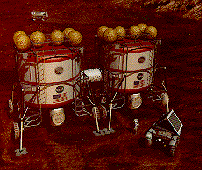 Soon after landing, the crew will position the crew and
laboratory modules next to one another and the two modules will be
connected.
Soon after landing, the crew will position the crew and
laboratory modules next to one another and the two modules will be
connected.
 The pressurized surface rover will be capable of long duration surface
expeditions, possibly up to weeks at a time. For shorter surface
excursions in the 6 to 8 hour range, unpressurized rovers will be used by
crew members wearing extravehicular activity (EVA) suits.
The pressurized surface rover will be capable of long duration surface
expeditions, possibly up to weeks at a time. For shorter surface
excursions in the 6 to 8 hour range, unpressurized rovers will be used by
crew members wearing extravehicular activity (EVA) suits.
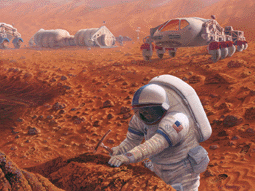 The astronauts will study the geology and mineralogy of the surrounding
area and will search for evidence of life, either past or present. They
will also look for water in the Martian soil or subsurface.
The astronauts will study the geology and mineralogy of the surrounding
area and will search for evidence of life, either past or present. They
will also look for water in the Martian soil or subsurface.
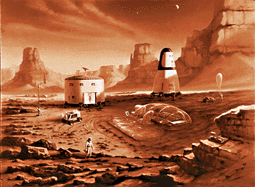 In addition,
the astronauts will have leisure time so that they can appreciate the
experience of being the first humans to ever walk on Mars!
In addition,
the astronauts will have leisure time so that they can appreciate the
experience of being the first humans to ever walk on Mars!
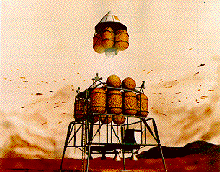 At the end of their 16 to 18 month stay on the surface, the crew will climb
aboard the Mars ascent vehicle (MAV) in mid 2011. The MAV is a single
stage launch vehicle that is designed for the short flight from the
surface to the orbiting Earth return vehicle (ERV).
At the end of their 16 to 18 month stay on the surface, the crew will climb
aboard the Mars ascent vehicle (MAV) in mid 2011. The MAV is a single
stage launch vehicle that is designed for the short flight from the
surface to the orbiting Earth return vehicle (ERV).
 The MAV will rendezvous with the orbiting (now fully fueled) ERV soon after
launch. The ERV is composed of a propulsive stage, a transit module, and
an Earth entry capsule (EEC). The crew will jettison the MAV while still
in Martian orbit. The return trip to Earth will last 180 days. As they
approach Earth, the astronauts will separate from the transit module and
spent propulsive stage, both of which will continue past the Earth into
deep space.
The MAV will rendezvous with the orbiting (now fully fueled) ERV soon after
launch. The ERV is composed of a propulsive stage, a transit module, and
an Earth entry capsule (EEC). The crew will jettison the MAV while still
in Martian orbit. The return trip to Earth will last 180 days. As they
approach Earth, the astronauts will separate from the transit module and
spent propulsive stage, both of which will continue past the Earth into
deep space.
 The EEC will re-enter the Earth's atmosphere, similar to the
manned missions of the 1960's. The crew will use a parafoil on the EEC to
steer themselves to a safe landing on Earth's surface.
The EEC will re-enter the Earth's atmosphere, similar to the
manned missions of the 1960's. The crew will use a parafoil on the EEC to
steer themselves to a safe landing on Earth's surface.
Go to
next section.












